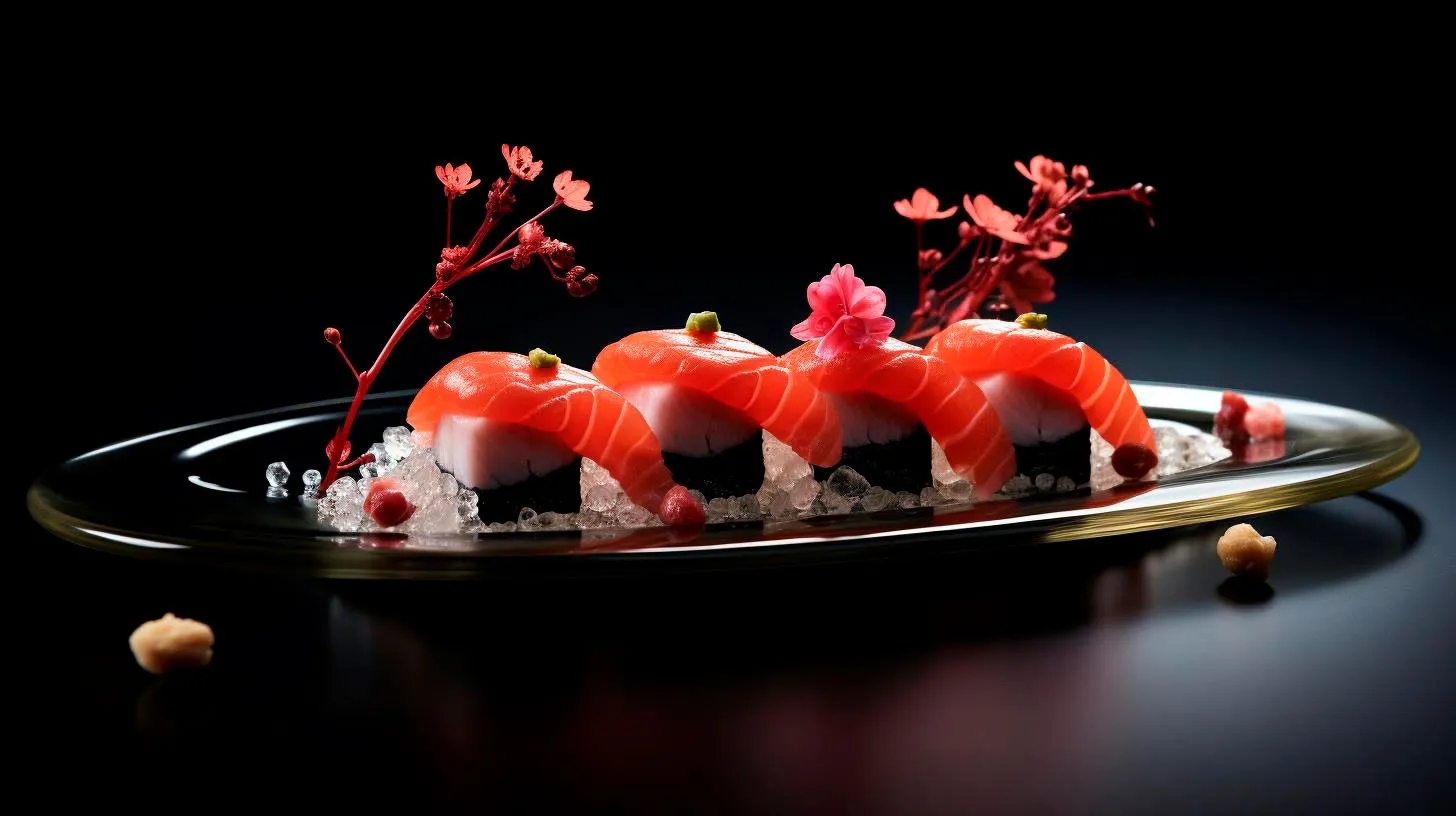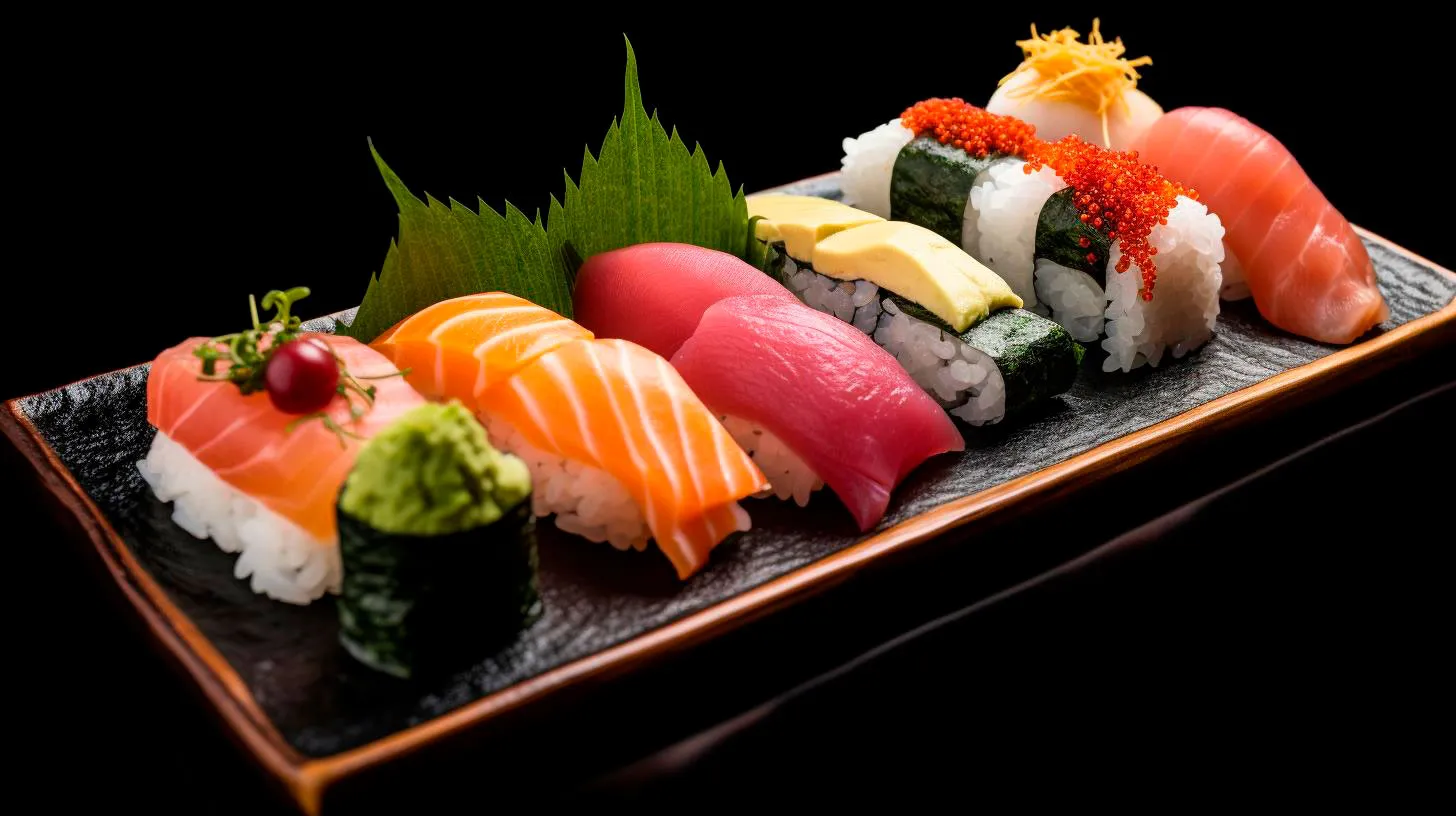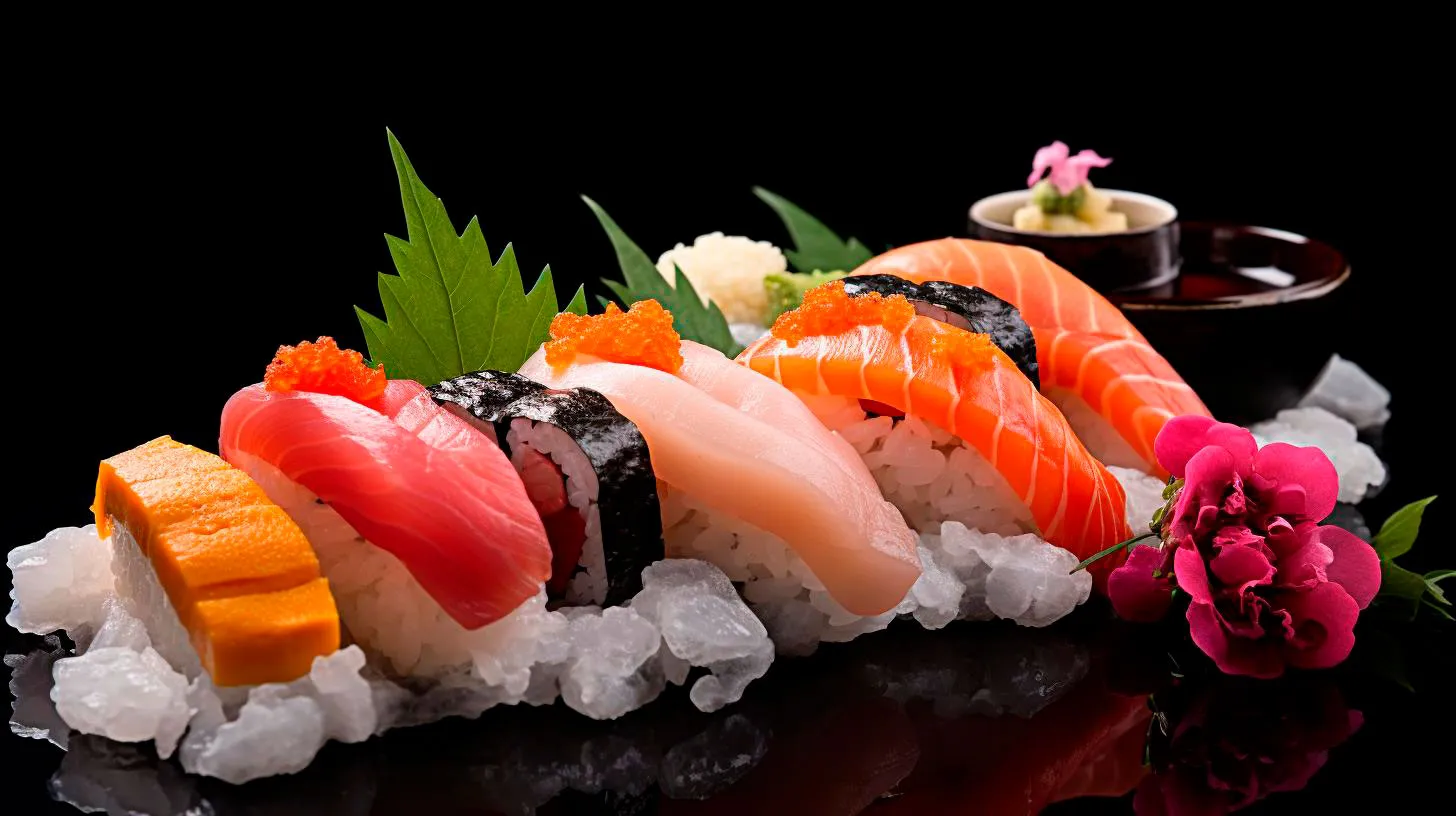Unleashing Creativity in the Kitchen: The World of Sushi Artistry
Sushi artistry has taken the world by storm, captivating both food enthusiasts and artists alike.
If you’ve ever been to a sushi restaurant, you’ve likely marveled at the beautifully presented rolls that resemble works of art. These creations go beyond mere sustenance—they engage your senses and stimulate your imagination. In this article, we’ll take a closer look at the fascinating world of sushi artistry, its techniques, and the key takeaways you can apply to unleash your own creativity in the kitchen.
The Art of Sushi Making
While sushi making dates back centuries, sushi artistry brings a fresh perspective and elevates the dining experience to new heights. Skilled sushi chefs, known as itamae, combine their culinary expertise with artistic vision to create visually stunning and delectable dishes that reflect their creativity. Here are some key points to consider when exploring the art of sushi making:
- Ingredient Selection: Sushi artistry relies heavily on high-quality ingredients. The freshest fish, vibrant vegetables, and authentic Japanese rice are carefully chosen to ensure the best flavor and texture.
- Techniques: Sushi artistry encompasses a wide range of techniques, including maki rolls, nigiri, temari, and sashimi. Each technique requires precision and practice to master, resulting in beautifully crafted pieces of edible art.
- Flavor Pairings: Creativity shines through in the flavor combinations used in sushi artistry. Chefs experiment with unique elements such as flavored sauces, spices, and unconventional pairings to create surprising taste profiles.
The Role of Presentation
Sushi artistry is not only about the taste but also about the visual appeal of the dish. The artful presentation of sushi rolls is what makes it truly captivating. Here are some elements that contribute to the visual delight of sushi artistry:
- Color Palette: Vibrant colors play a significant role in sushi artistry. Chefs carefully select ingredients that bring contrasting colors to the plate, creating a visually striking composition.
- Texture and Shape: The texture and shape of the ingredients used in sushi artistry add depth to the overall presentation. From the smoothness of raw fish to the crunchiness of fresh vegetables, each component adds a distinct visual and textural element.
- Garnishes and Accents: Artful garnishes, such as edible flowers or delicate microgreens, add a touch of elegance to the dish. Additionally, the careful placement of tiny accents like sesame seeds or colorful sauces adds a burst of flavor and creativity.
Unleashing Your Creativity
While sushi artistry may seem intimidating to beginners, there are several ways you can channel your creativity and add your own spin on this culinary art form. Here are some key takeaways to help unleash your creativity in the kitchen:
- Experiment with Ingredients: Don’t be afraid to explore unique flavors and ingredients. Combining traditional sushi elements with your personal favorites can result in surprising and delightful combinations.
- Play with Colors and Textures: Just as in traditional sushi artistry, experiment with contrasting colors and textures. Incorporate vibrant vegetables, thinly sliced fruits, or even edible flowers to create a visually stunning presentation.
- Master Sushi Techniques: Practice different sushi techniques, such as rolling maki or creating nigiri. Make it a fun and interactive experience, involving friends or family to enhance the enjoyment of your sushi artistry journey.
- Draw Inspiration from Nature and Art: Explore artistic forms beyond the culinary world. Draw inspiration from nature, architecture, or even paintings to create unique and aesthetically pleasing sushi art pieces.
According to recent industry statistics, the popularity of sushi has grown significantly, with over 45,000 sushi restaurants around the world, generating approximately $15 billion in revenue annually. Amidst this growth, sushi artistry stands out as a unique and captivating culinary trend that continues to inspire both chefs and diners alike.
In Conclusion
Sushi artistry has undoubtedly revolutionized the way we perceive food. Its fusion of culinary expertise and creativity has paved the way for an entirely new dining experience. By exploring the techniques, presentation, and key elements of sushi artistry, you can unleash your own culinary creativity and embark on a delicious journey like no other. Let the world of sushi artistry inspire you to experiment, create, and savor the beauty of your edible masterpieces.
A Fusion of Culinary Delights: Marrying Aesthetics and Gastronomy
This trend has transformed the way we experience food, creating a multidimensional culinary journey that is as visually appealing as it is delicious.
From vibrant and carefully plated dishes to immersive dining experiences, the fusion of aesthetics and gastronomy has revolutionized the culinary world, bringing new dimensions to the dining table. Let’s delve into this fascinating trend and explore its key features, advantages, and takeaways.
Key Features of the Fusion of Aesthetics and Gastronomy
- Artistic Plating: Chefs are embracing their inner artists, transforming the presentation of dishes into visually stunning creations. The fusion of aesthetics and gastronomy encourages chefs to experiment with colors, textures, and arrangement, resulting in plates that are almost too beautiful to eat.
- Sensory Experiences: It’s not just about taste! Aesthetic culinary experiences often engage all the senses, immersing diners in a multi-sensory journey. From the aroma of a perfectly seared steak to the sound of crackling crust, every element is carefully curated to create an unforgettable dining experience.
- Interactive Dining: With the fusion of aesthetics and gastronomy, dining becomes more than simply enjoying a meal. Chefs are pushing the boundaries, incorporating interactive elements such as edible sculptures, molecular gastronomy techniques, and tableside preparations. This interactive approach adds an element of entertainment and surprise to the dining experience.
Advantages of Aesthetics and Gastronomy Fusion
The fusion of aesthetics and gastronomy offers numerous advantages for both chefs and diners, revolutionizing the culinary landscape:
- Enhanced Dining Experience: By elevating the visual aspect of dishes, the fusion of aesthetics and gastronomy enhances the overall dining experience. The presentation of a dish not only whets the appetite but also sets the stage for a memorable meal.
- Expanding Palates: Aesthetically pleasing dishes encourage diners to venture outside their culinary comfort zones. The enticing presentation of a dish sparks curiosity, prompting individuals to try new flavor combinations and ingredients.
- Social Media Appeal: In the era of social media, visually captivating food posts have become ubiquitous. Restaurants embracing the fusion of aesthetics and gastronomy have an edge in attracting customers who are eager to capture and share their dining experiences online, providing free publicity and exposure.
- Cross-Cultural Exchanges: The fusion of aesthetics and gastronomy showcases the diverse culinary heritage from around the world. Chefs draw inspiration from different cultures, resulting in fusion cuisine that blends traditional flavors and techniques with contemporary presentation, creating unique cross-cultural dishes.
Key Takeaways from the Fusion of Aesthetics and Gastronomy
The fusion of aesthetics and gastronomy is a trend that continues to shape the culinary world. Here are the key takeaways:
- Visual Appeal Matters: Chefs should prioritize the visual presentation of their dishes, as it plays a vital role in enhancing the dining experience.
- Engage All Senses: Create dining experiences that go beyond taste, engaging the senses of sight, smell, sound, and touch.
- Embrace Innovation: Stay open to experimentation and embrace innovative techniques to create visually stunning and memorable dishes.
- Cultural Influences: Draw inspiration from diverse culinary traditions to create fusion dishes that celebrate cross-cultural influences.
As the fusion of aesthetics and gastronomy continues to captivate food enthusiasts, it is clear that this trend is here to stay. The marriage of art and food brings a new level of creativity to the culinary world, pushing boundaries and challenging traditional notions of what a dish should look like. So, next time you sit down for a meal, prepare to be wowed by the fusion of culinary delights that not only pleases your taste buds but also entices your visual senses.
A Feast for the Eyes: Discover the Art of Sushi
In this article, we delve into the world of sushi and explore the mesmerizing artistry behind this iconic Japanese dish.
The Essence of Sushi
Sushi originated in Japan and has since become a global sensation. It is a culinary masterpiece that combines the freshest ingredients with exquisite precision. Traditionally, sushi consists of vinegared rice, known as shari, paired with an assortment of toppings, such as raw or cooked seafood, vegetables, and condiments like soy sauce and wasabi.
What sets sushi apart is not just its remarkable taste, but also the way it is presented. Sushi chefs take immense pride in crafting visually appealing dishes that please both the eye and the palate. The art of sushi lies in its ability to captivate and engage all of our senses simultaneously.
The Visual Symphony
When your plate of sushi arrives, be prepared for a feast for the eyes. The vibrant colors of the fish, the glistening rice, and the carefully placed garnishes create a visually stunning presentation that is almost too beautiful to eat. Here are some key visual elements that make sushi a visual symphony:
- Color Harmony: Sushi chefs meticulously select ingredients to achieve a captivating color palette on the plate. From the rich red of tuna to the bright green of avocado, each color is carefully considered to create a visually appealing composition.
- Texture Contrast: Sushi is all about achieving the perfect balance of textures. From the smoothness of raw fish to the crunch of fresh vegetables, each ingredient adds a contrasting element that enhances the visual appeal.
- Precision and Symmetry: Sushi is a testament to the Japanese culture of precision and attention to detail. The perfect slices of fish and neatly arranged toppings showcase the chef’s skill and dedication to achieving balance and symmetry.
The Art of Sushi Making
Sushi making is an art form that requires years of training and practice. Sushi chefs, known as Itamae, master the techniques needed to create stunning sushi creations. Here are some key techniques that contribute to the artistry of sushi making:
- Nigiri: Nigiri is perhaps the most recognizable form of sushi. It consists of a hand-pressed mound of rice topped with a slice of fish or other toppings. The chef carefully shapes each piece to ensure it is visually appealing and perfectly balanced.
- Maki: Maki sushi, or sushi rolls, are created by wrapping a sheet of nori (seaweed) around a filling of rice, fish, and vegetables. The chef skillfully rolls and slices the sushi, creating stunning patterns and designs.
- Sashimi: While not technically sushi, sashimi is an integral part of Japanese cuisine. It showcases the delicate beauty of thinly sliced raw fish, skillfully presented to highlight the freshness and flavor of the seafood.
The Cultural Significance
Sushi not only offers a culinary experience but also reflects the culture and history of Japan. Here are some key takeaways that highlight the cultural significance of sushi:
- Seasonal Ingredients: The sushi tradition emphasizes the use of seasonal ingredients. This focus on freshness and seasonality ensures that each sushi creation maximizes flavor and quality.
- Minimalism: Japanese aesthetics revolve around simplicity and minimalism. Sushi embodies these principles with its clean presentation, highlighting the natural beauty of the ingredients.
- Storytelling: Sushi chefs strive to create an immersive dining experience. The careful arrangement and selection of ingredients tell a story, portraying the connection between nature, culture, and culinary art.
In conclusion, sushi is more than just a delicious meal. Its artistic presentation and cultural significance elevate it to a whole new level. The attention to detail and the mesmerizing visuals make sushi a feast for all the senses. So, the next time you indulge in this culinary delight, take a moment to appreciate the artistry behind each bite.
Elevating Culinary Education: The Intersection of Sushi and Art
Sushi, a traditional Japanese dish typically consisting of vinegared rice and various seafood or vegetables, has long been admired for its meticulous preparation and flavors. However, in recent years, sushi chefs have taken their craft to new heights by incorporating artistic elements into their creations. This evolution not only adds a visual component to the dining experience but also elevates sushi making to a form of artistic expression.
The Art of Sushi Making
Creating sushi is not just about assembling ingredients but also about the intricate process and attention to detail involved. Sushi chefs devote years to perfecting their craft, refining their techniques, and understanding the harmony between flavors and textures. By embracing the principles of art and design, these chefs transform sushi into a multi-sensory experience.
Here are some key takeaways on the art of sushi making:
- Sushi chefs meticulously select and arrange ingredients to create visually appealing presentations.
- They utilize various techniques, such as cutting fish in different shapes and sizes, to enhance the overall aesthetic of the dish.
- Colors and textures are carefully considered, resulting in visually stunning creations.
- Attention to detail is paramount, ensuring that each sushi roll is a work of art in itself.
The Intersection of Sushi and Art
While sushi has long been appreciated for its taste, the incorporation of artistic elements adds an extra layer of sophistication and intrigue. The fusion of culinary expertise and artistic expression creates a unique dining experience that engages all the senses.
Here are some of the advantages of the intersection of sushi and art:
- Enhanced dining experience: The visual beauty of sushi elevates the overall enjoyment of the meal.
- Creative freedom: Sushi chefs can express their artistic vision through their creations, pushing the boundaries of traditional sushi making.
- Increased marketability: Artistic sushi creations attract attention and can differentiate a restaurant in a competitive culinary landscape.
- Social media appeal: Instagrammable sushi dishes have gained popularity, driving social media engagement and attracting food enthusiasts.
The Future of Sushi and Art
The fusion of sushi and art shows no signs of slowing down. As the demand for unique dining experiences continues to grow, sushi chefs are exploring new ways to incorporate artistic elements into their creations. This intersection not only offers endless possibilities for artistic expression but also opens doors for collaborations between sushi chefs and artists from different disciplines.
According to recent industry statistics:
- 66% of millennials consider the aesthetic appeal of food when deciding where to dine.
- The global sushi market is projected to reach a value of $26 billion by 2026, driven by increasing interest in Japanese cuisine and sushi’s appeal as an art form.
- Art-inspired sushi restaurants have seen a surge in popularity in major cities worldwide, with customers seeking immersive dining experiences.
In conclusion, the artistry in sushi making has elevated the culinary education and dining experience, merging two traditionally distinct realms. Sushi chefs not only prepare delicious and flavorful dishes but also create edible masterpieces that engage all the senses. With the ever-growing demand for unique dining experiences, the intersection of sushi and art will continue to captivate food enthusiasts and push the boundaries of culinary creativity.


